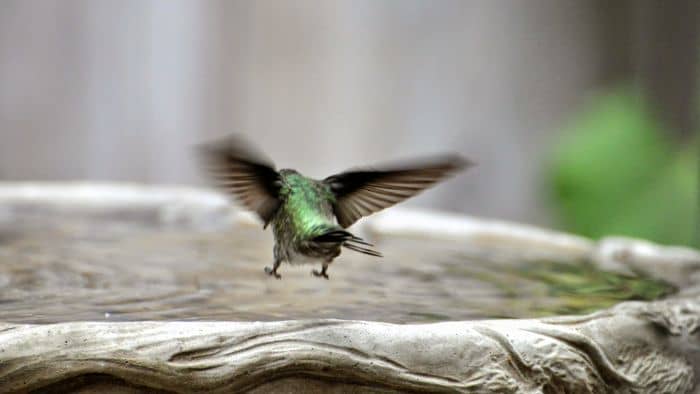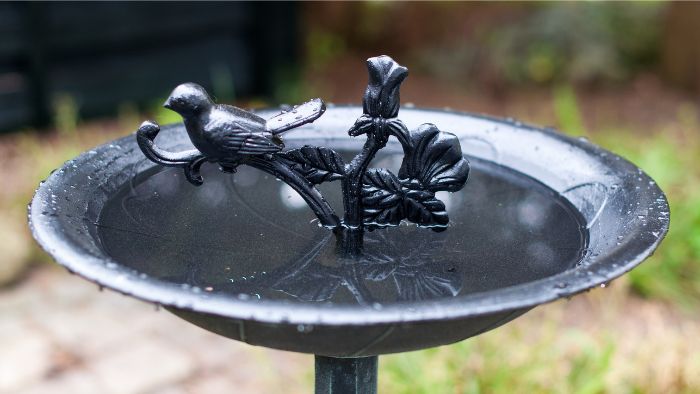The birdbaths for hummingbirds are one of the best ways to attract these beautiful, small birds to your garden. Keep reading and find out more.
Hummingbirds are small, magical, and colorful flying creatures that simply attract attention wherever they appear. There is almost no person who is not thrilled when sees them for the first time.
Would you like to host them in your garden? You have come to the right place! Putting birdbaths for hummingbirds is a great way to entice them, as these birds need special consideration for an appropriate water source. Keep in mind that these delicate birds really appreciate those backyard birders who help them get through the hot summer days.
Do Hummingbirds Need A Source Of Water?
This is one of the most common questions we need to offer an adequate answer to before we tell you more about birdbaths for hummingbirds. Truth be told, these birds are not too frequent visitors to water sources. The primary reason is that most of the fluid they need comes from nectar that they consume in large quantities.
As for the water, it helps them to wash the sticky residue off their feathers as well as to keep the plumage in the best possible condition. Any birder who knows how much these birds appreciate will try to build a few birdbaths for hummingbirds, and along the way take the opportunity to watch these beauties bathe and preen.
The Most Interesting Forms Of Birdbaths For Hummingbirds; What To Choose?
If you have those classic fountains intended for the enjoyment of larger species of birds, we will have to disappoint you by admitting that they are not suitable for these hummers. Namely, birdbaths for hummingbirds are usually much shallower than the classic ones, so that these birds can rest and feel safe while cleaning their feathers. Find more details below.
Misters
Positioning a mister to spray nearby broad leaves is one of the best things you can do for these birds. This is an extremely effective method of bringing water to hummingbirds because its characteristic sound attracts these birds, and if they feel safe enough, these birds may also fly through it, hover in it, or get wet directly.
Misting Sprinklers
Adding sprinkler heads to your lawn or garden can be one of the most creative birdbaths for hummingbirds. Why? Because they create a mist source that helps water grass or flowers and in addition provide water to these birds. Misting sprinklers are a very cost-effective method because all the water is used to the maximum.

Drippers
Slow droppers added to birdbaths for hummingbirds are a great option because birds can rub against wet objects to bathe or stand under a dropper to get directly to the water. In addition, the distinctive sound of this device is guaranteed to attract all nearby hummers as well as other species of birds that hear the splashes.
Fountains
Fountains are by far the most beloved type of birdbaths for hummingbirds, all because of the shallow spots where the water runs over ledges, lips, and rims. Almost every inch of the fountain can be used for swimming, as well as for rest and entertainment. What more could a hummer want?
Experts recommend choosing those fountains that have small bubblers and rough textures such as slate slabs. These types give the birds enough space to access the water where they can feel safe and comfortable.
How To Maintain Birdbaths For Hummingbirds?

Good news for everyone, maintaining a bird bath is very simple. Pay special attention to the water level, especially on those windy days. Also, keep an eye on all those birdbaths for hummingbirds that have a pump to make sure it doesn’t run dry.
Solar fountains are a great option primarily because you don’t need an electrical outlet, and accordingly, you can place them almost anywhere. However, keep in mind that it may temporarily stop spraying on cloudy days or if a large cloud is moving over the sun.
Most experts advise cleaning your birdbaths for hummingbirds every two to three days. The procedure is very simple, all you need to do is disassemble it, brush it well and wash it with warm water. When you are done, fill it with water and that’s it, it’s ready to be used.
To Conclude
Installing one or more birdbaths for hummingbirds greatly increases your chances of enjoying watching hummingbirds while playing, feeding, and resting. We must not forget to mention that it also acts as a natural-friendly decoration in your backyard garden as well.
If you have any questions feel free to contact us in the comments below. We are expecting you.
Happy birdwatching everyone!
Read more Can Hummingbirds Survive Cold Weather? No. 1 Method To Help These Amazing Creatures
FAQ’s
[rank_math_rich_snippet id=”s-4007b47e-30a4-4efd-baad-7c3376a678f6″]


